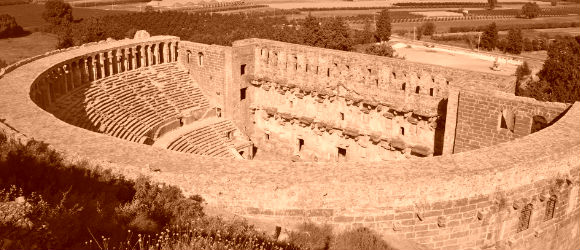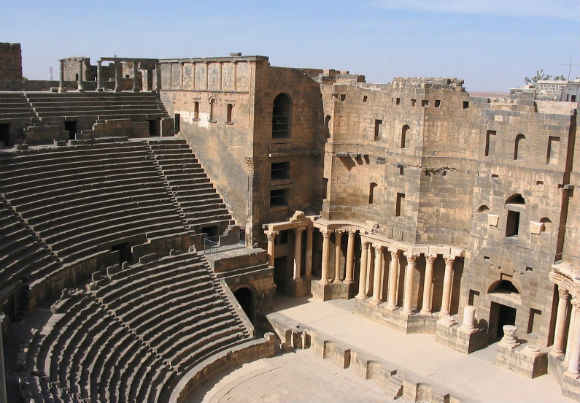Aspendos was an ancient Greco-Roman city in Antalya province of Turkey. It is located 7 kilometres (4.3 mi) northeast of central Serik.
Aspendos was an ancient city in Pamphylia, Asia Minor, located about 40 km east of the modern city of Antalya, Turkey. It was situated on the Eurymedon River about 16 km inland from the Mediterranean Sea; it shared a border with, and was hostile to, Side. According to later tradition, the (originally non-Greek) city was founded around 1000 BC by Greeks who may have come from Argos. The wide range of its coinage throughout the ancient world indicates that, in the 5th century BC, Aspendos had become the most important city in Pamphylia. At that time the Eurymedon River was navigable as far as Aspendos, and the city derived great wealth from a trade in salt, oil, and wool.
Aspendos did not play an important role in antiquity as a political force. Its political history during the colonization period corresponded to the currents of the Pamphylian region. Within this trend, after the colonial period, it remained for a time under Lycian hegemony. In 546 B.C. it came under Persian domination. The face that the city continued to mint coins in its own name, however, indicates that it had a great deal of freedom even under the Persians.
In 467 B.C. the statesman and military commander Cimon, and his fleet of 200 ships, destroyed the Persian navy based at the mouth of the river Eurymedon in a surprise attack. In order to crush to Persian land forces, he tricked the Persians by sending his best fighters to shore wearing the garments of the hostages he had seized earlier. When they saw these men, the Persians thought that they were compatriots freed by the enemy and arranged festivities in celebration. Taking advantage of this, Cimon landed and annihilated the Persians. Aspendos then became a member of the Attic-Delos Maritime league.
The Persians captured the city again in 411 B.C. and used it as a base. In 389 B.C. the commander of Athens, in an effort to regain some of the prestige that city had lost in the Peloponnesian Wars, anchored off the coast of Aspendos in an effort to secure its surrender. Hoping to avoid a new war, the people of Aspendos collected money among themselves and gave it to the commander, entreating him to retreat without causing any damage. Even though he took the money, he had his men trample all the crops in the fields. Enraged, the Aspendians stabbed and killed the Athenian commander in his tent.
When Alexander the Great marched into Aspendos in 333 B.C. after capturing Perge, the citizens sent envoys to him to request that he would not establish that he be given the taxes and horses that they had formerly paid as tribute to the Persian king. After reaching this agreement. Alexander went to Side, leaving a garrison there on the city’s surrender. Going back through Sillyon, he learned that the Aspendians had failed to ratify the agreement their envoys had proposed and were preparing to defend themselves. Alexander marched to the city immediately. When they saw Alexander returning with his troops, the Aspendians, who had retreated to their acropolis, again sent envoys to sue for peace. This time, however, they had to agree to very harsh terms; a Macedonian garrison would remain in the city and 100 gold talents as well as 4.000 horses would be given in tax annually.
In 190 BC the city surrendered to the Romans, who later pillaged it of its artistic treasures. Toward the end of the Roman period the city began a decline that continued throughout Byzantine times.
Aspendos,



This is one of the most intact amphitheatres I have seen and I have been to the Coliseum in Rome! It is very reasonable to get in – just a couple of pounds. There is some information around about the ruins but it is a little limited. A short walk from the amphitheatre are temple ruins and some aqueducts –…
Fantastic place to visit. Incredibly atmospheric and well-preserved. Great that one can just wander around virtually anywhere on the site. One can easily to imagine the clang of swords, roars of the lions and the howling of the spectators! Would love to see an opera there – great acoustics.
Aspenos theatre was amemory for me since I had visited when I was 7 yearsold.I never forot
and after I got my guidinglicense I had visited this theater more than 100 timeI
It's sofar one of the best items 'nTukey located near toAntalya
The thetre 's almost complete
the area is cleam
even though there are more than 1000 v's'tors…
very impressive but gift shop expensive and if you want to use the toilet its 1euro, the amphitheatre was great but to go up those steps were very daunting and some were loose so you needed to watch your step
If you visit this region of Turkey, you must visit these ruins and surrounding areas. We had a lovely time walking around them with our guide Mustapha telling us all about the History of the ruins and bridge.
Fabulous roman ampitheatre, sympathetically restored. You need to be fit to climb the steps to the top and like heights.
Aspendos is amazingly beautiful.
Not only by its beauty but its historical background; the legend behind it, the imposing stairs, Don't forget to try the strong echo with your friends and family, …..
One of the most beautiful historical monuments near Antalya.
You can also take pictures with gladiators ( men dressed in costumes ) and have the pictures photoshoped…
Even if your not an history enthusiast, you will be amazed and facinated by this attraction. I would highly recommend a visit if you are in the Alanya area, or there abouts. If you are a history buff, you will soak in the atmosphere and imagine what a site it must have been in it's original state.
i found the entry of 15 TL a bit too much compared to other places like Perge (15TL) etc. There is not soo much too see. Still, its a very nice theater.
IF you go, do it around 4pm to 5 pm, when the masses are gone.
These two attraction were wonderful the Roman remain and the Ampetheartre are well worth a visit truly remarkable